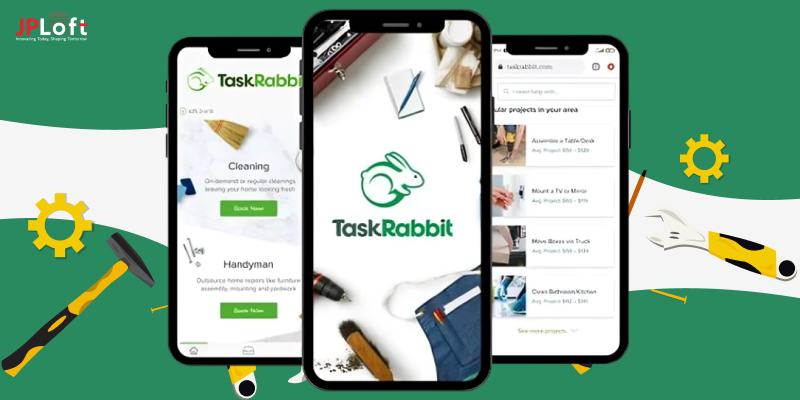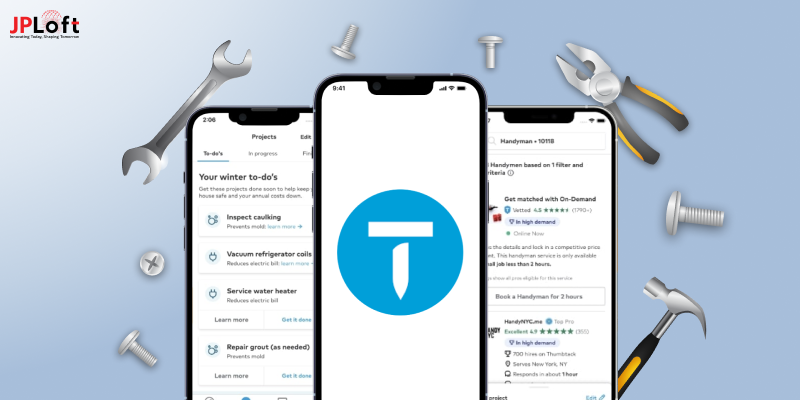Creating a successful handyman app can be a rewarding yet challenging process. While these apps simplify finding skilled professionals for home services, developers often face various hurdles during the development phase.
From ensuring smooth user experience to integrating secure payment systems, overcoming these issues is crucial for building a reliable app. In this guide, we'll discuss the major development challenges of a handyman app and how to tackle them effectively.
If you are a business owner or a developer, understanding these handyman app development challenges will help you plan better and avoid costly mistakes.
Let's explore the top development challenges of a handyman app and how to overcome them for a successful launch.
Understanding Handyman App and Its Market Statistics
A handyman app is a digital platform that connects users with skilled service providers for household repairs, maintenance, and other tasks.
These apps allow users to book professionals for services like plumbing, electrical work, painting, cleaning, and more.
With handyman app features like real-time booking, payment integration, and in-app chat, handyman apps offer a seamless experience for both customers and service providers.
Popular apps like TaskRabbit, Thumbtack, and Urban Company have revolutionized the on-demand service industry by simplifying service bookings through a mobile interface.
Market Statistics for Handyman Apps
Here are some important market facts that show how the handyman app business is growing:
- The market for on-demand home services is expected to grow at a CAGR of 16.7% and hit $1,574.86 billion by 2030. (Source)
- In 2023, the handyman services market was worth USD 1.65 billion. It will grow at a CAGR of 10% from 2024 to 2031 and reach USD 3.3 billion by 2031. (Source)
- The US Home Service Market Size will grow at a rate of 36.22% over the next five years, as planned, and hit a value of USD 1.08 billion. (Source)
- The online home service market is predicted to grow by USD 8.21 trillion during 2023-2028, accelerating at a CAGR of 75.8% during the estimated period.
- Apps like TaskRabbit and Thumbtack collectively generate millions in annual revenue, showcasing the strong earning potential of handyman apps.
These figures highlight the growing market for handyman apps, making it a profitable chance for companies looking to enter this space. Now, let’s move on to the next section to understand the challenges that you may face while developing a handyman app.
Handyman App Development Challenges and Their Solutions
Developing a successful handyman app comes with its own set of technical, operational, and security challenges. To ensure your app functions efficiently and offers a seamless user experience, it’s crucial to address these challenges during the development process.
Below are the handyman app development challenges along with practical solutions to overcome them.
1. User Authentication and Profile Management
One of the biggest development challenges for a handyman app is coming up with a safe but easy to use login system.
The process of signing up should be quick and easy, and it should also be safe. Users may give up on the app before finishing the signup process if the registration steps are too hard to understand.
On the other hand, if security measures are weak, the app becomes open to data breaches and hacking attempts. Implementing multi-factor authentication (MFA), social media login choices and biometric verification can add complexity to the mobile app development process, making it difficult to balance security with ease.
Moreover, ensuring seamless profile management, including updates, personal pictures, and service choices, demands careful planning to avoid speed issues.
What to do: To handle this challenge, adopt two-factor authentication (2FA) for better security. Providing choices for social media logins (Google, Facebook) offers faster sign-ups while keeping security.
Additionally, integrating known name verification tools can avoid fake profiles. Using encrypted systems to store user information further protects private data.
2. Service Provider Verification
Ensuring only qualified and known service providers join your platform is vital for keeping credibility.
This is a major development challenge for a handyman app as fake accounts or unverified workers can lead to poor service quality, bad reviews, and customer unhappiness. You need to build a reliable verification method that includes ID checks, background verification, and proof of experience.
Integrating third-party background check APIs can ease this process but requires extra effort and technical integration. Additionally, keeping current records for service providers’ licenses, certifications, and insurance adds another layer of complexity.
What to do: Introduce a detailed verification method that includes background checks, name verification, and license screening. Implement a step-by-step approval method that needs documents, licenses, and related skills validation.
Integrating third-party identification services can simplify this process. Additionally, having a review and rating system allows users to examine service providers based on past experiences.
3. Real-Time Tracking and GPS Integration
Accurate GPS tracking is important for handyman apps to help users track service providers in real time. However, adding this function comes with technical challenges.
GPS systems can face connectivity issues in areas with weak signals, resulting in incorrect position updates or tracking delays. Moreover, mistakes in map merging can lead to misdirected service providers, hurting customer experience.
Factors like bad internet access, wrong map data, and delays in tracking changes make this one of the biggest development challenges in handyman apps. You must also ensure that GPS functionality works efficiently without draining the device’s battery.
What to do: Using trusted mapping APIs like Google Maps, Mapbox, or Waze can improve positioning accuracy. Integrating geofencing allows for better precision and helps provide users with accurate ETAs.
Combining GPS with real-time alerts further enhances user engagement and ensures a smoother experience. Addressing these issues is vital to overcoming challenges while developing a handyman app and ensuring seamless tracking.
4. Payment Gateway Integration
Secure and smooth online payments are important for handyman apps, but adding payment methods can be a complicated process.
Dedicated developers ensure that payment systems meet security standards like PCI DSS to protect private data. Technical problems such as failed deals, payment delays, or restricted payment choices can frustrate users.
Additionally, accommodating various payment methods such as credit cards, digital wallets, and UPI adds to the complexity. Payment platform integration must also handle returns, partial payments, and commission management, further complicating development.
What to do: Integrate trusted payment systems like Stripe, PayPal, or Razorpay that offer multiple payment choices (credit/debit cards, e-wallets, UPI, etc.).
Implementing tokenization and PCI DSS compliance improves payment security, protecting user data from possible threats. Providing safe return methods also builds user trust.
5. Scheduling and Availability Management
Managing plans, delays, and changing quickly is one of the most common development challenges for a handyman app.
Without a strong scheduling system, users may face overlapping appointments, wrong time slots, or unnotified cancels. Coordinating multiple service providers across different time zones and ensuring real-time changes in plans makes development more difficult.
Designing a dynamic booking system helps to respond to sudden changes, such as a professional’s absence or unexpected delays. Additionally, adding automatic reminders and alerts to keep users and service providers aware further adds to the complexity.
What to do: Implement a dynamic schedule system that syncs with the handyman's calendar and shows availability in real time.
Adding automatic alerts, booking boundaries, and progress updates ensure a smoother scheduling process. Integrating AI-powered planning systems can further improve time slots based on user demand.
6. User Data Security
Ensuring robust data security is one of the main development challenges of a handyman app.
These apps handle highly sensitive user data, including addresses, phone numbers, and payment details. Without strong app security measures, this data becomes vulnerable to hacking, identity theft, and data breaches.
Developers must encrypt data both during transmission and while stored on servers to protect against cyber threats. Additionally, secure login methods like two-factor authentication (2FA) and biometric verification are crucial to enhancing security.
Failing to implement proper security protocols can result in user distrust, legal issues, and reputational damage, making this a critical aspect of handyman app development challenges.
What to do: Strengthen security by combining SSL keys, end-to-end encryption, and safe cloud storage options.
Implementing role-based access control and performing regular security checks can reduce risks. Data backup systems also ensure data recovery in case of hacking.
7. Managing Cancellations and Refunds
Frequent cancellations and refund disputes pose one of the biggest development challenges in handyman apps.
When users cancel bookings, delays in refund processing can lead to dissatisfaction. On the other hand, service providers may face financial losses if cancellations are too frequent.
Developing a flexible yet controlled cancellation policy that fairly benefits both users and service providers requires strategic planning. Integrating automated refund systems, clear cancellation policies, and real-time updates can improve the refund experience.
Balancing user convenience with business profitability is key, making this a major concern in the list of handyman app challenges.
What to do: Establish clear cancelling and refund rules within the app. Automate repayment processes to ensure fast outcomes.
Additionally, sending reminder emails before planned bookings can reduce last-minute cancellations. Offering partial returns based on time can help keep a fair balance for both users and service providers.
8. Scalability and Performance Optimization
Scalability is often overlooked but is one of the top development challenges of a handyman app.
As your app grows and attracts more users, the system must manage increasing data loads, multiple service requests, and real-time updates efficiently. Without proper optimization, the app may slow down, resulting in crashes or delays.
The best mobile app development company focuses on building a strong backend infrastructure that can handle growth without compromising performance.
Efficient database management, content delivery networks (CDNs), and cloud storage solutions can improve scalability, ensuring your app delivers a smooth experience even during peak usage.
What to do: Build your app using scalable cloud platforms like AWS, Google Cloud, or Microsoft Azure to handle traffic effectively.
Implement caching mechanisms and content delivery networks (CDNs) to improve reaction speeds and lower server load. Regular speed testing ensures your app can grow seamlessly.
9. UI/UX Design for Better Engagement
A badly designed user interface can lead to confusion, abandoned plans, and negative user feedback.
Designing a simple, visually appealing layout is a major development challenge of a handyman app. Users expect clear navigation, simple service booking choices, and easy entry to key features. Complex options, cluttered layouts, or slow page loading can annoy users and lower engagement rates.
You should build a seamless user trip with well-placed CTAs (Call-to-Actions), clear icons, and approachable design principles.
Prioritizing user feedback during the planning phase can help improve app usability and interest. Investing in an effective UI/UX strategy is vital to overcoming this handyman app development challenge and improving customer retention.
What to do: Focus on wireframing, prototyping for easy access with simple icons, clear CTAs (Call to Actions), and organized menus to overcome this handyman app development challenge.
Using appealing images, minimalistic layouts, and step-by-step booking flows can improve the user trip. Conducting user feedback meetings helps spot pain points and refine the design accordingly.
10. Compliance with Local Regulations
Ensuring your handyman app follows regional laws and regulations is one of the major development challenges of a handyman app. Meeting local laws and rules is important for any handyman app working in different areas.
Each country may have specific legal requirements regarding worker licenses, insurance coverage, and customer security policies. Failure to comply with these rules can result in fines, lawsuits, or even app suspension.
Ensuring that the handyman app meets these legal standards is a top development challenge of a handyman app.
You must study and implement necessary compliance features such as insurance merging, service provider licensing management, and data protection policies.
Collaborating with an on-demand app development company during the development phase can help ensure the app sticks to regional laws without delays.
What to do: To elaborate on this handyman app development challenge, collaborate with legal experts to ensure your app meets regional compliance laws.
Establish terms of service and privacy rules within the app to explain responsibilities for both users and service providers.
Following industry standards such as GDPR or CCPA provides data security and legal compliance.
Addressing these challenges while building a handyman app effectively ensures users have a safe, flexible, and hassle-free payment experience.
How JPLoft Can Help You Overcome These Challenges?
At JPLoft, we specialize in building robust and user-friendly handyman apps that tackle the most common development challenges effectively.
As a trusted handyman app development company, our expert developers follow best practices to ensure seamless user authentication, accurate GPS tracking, and secure payment integration.
We implement trusted APIs, integrate secure payment gateways, and follow data protection standards to safeguard user information. Our team also ensures that your app meets local regulations and offers scalable solutions to manage growing user demands.
Whether you're looking to create a mobile app from scratch or improve your existing handyman platform, JPLoft provides tailored solutions to meet your business goals. Partner with us to develop a reliable and high-performing handyman app that stands out in the competitive market.
Conclusion
Developing a successful handyman app requires careful planning and strategic solutions to overcome various challenges.
From ensuring secure user authentication to integrating real-time tracking and managing complex payment gateways, each step plays a crucial role in the app’s performance.
By addressing these handyman app development challenges effectively, you can create a seamless platform that enhances user experience and drives business growth.
Collaborating with experienced developers and implementing proven solutions can simplify the development process. If you are ready to build a reliable and feature-rich handyman app, investing in the right strategies will help you stay ahead in the competitive market.
FAQs
Some major development challenges of handyman apps include user authentication, real-time tracking, payment gateway integration, data security, and managing cancellations. Each challenge requires proper planning and technical expertise to ensure smooth app functionality.
To manage payment security, integrate trusted gateways like Stripe, PayPal, or Razorpay. Ensure compliance with PCI DSS standards and implement tokenization to protect sensitive data.
Using reliable mapping APIs such as Google Maps, Mapbox, or Waze can improve location accuracy. Additionally, combining GPS with geofencing and real-time alerts can enhance tracking efficiency.
To reduce cancellations, implement clear cancellation policies, automated reminders, and offer flexible rescheduling options. Providing strong customer support also helps manage disputes effectively.
To ensure scalability, invest in cloud-based infrastructure, adopt microservices architecture, and implement caching strategies. Regular performance testing will help maintain app speed and stability.
A well-designed interface improves user engagement and simplifies navigation. Focusing on intuitive design, clear icons, and easy booking processes can enhance user satisfaction.














Share this blog